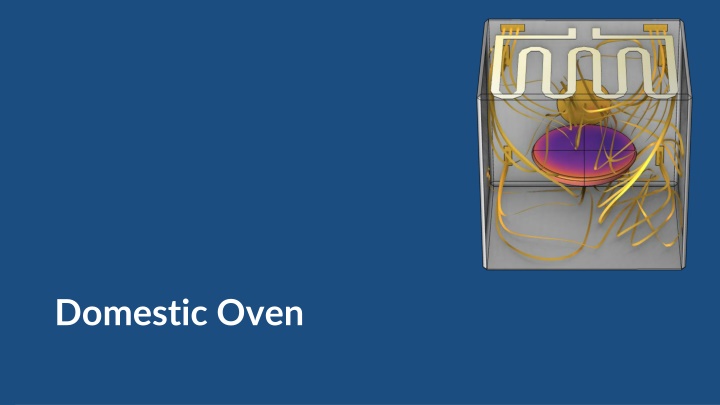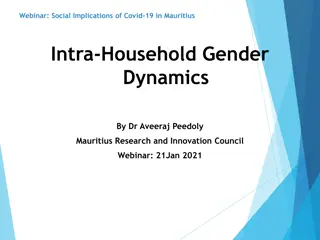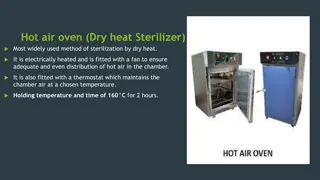
Understanding Heating Process of Pie in Domestic Oven
This example explores the heating process of a pie in a domestic oven, considering conduction, convection, and radiation. Two computational approaches are compared: one-way nonisothermal flow and fully coupled nonisothermal flow. The model includes top and back resistances, a temperature probe at the outlet, air blown through inlets, thermal insulation, and a thermostat controlling power supply based on the outlet temperature. Results show that the oven quickly reaches the target temperature of 220°C, while the pie heats slowly with the top resistance reaching about 280°C.
Download Presentation

Please find below an Image/Link to download the presentation.
The content on the website is provided AS IS for your information and personal use only. It may not be sold, licensed, or shared on other websites without obtaining consent from the author. If you encounter any issues during the download, it is possible that the publisher has removed the file from their server.
You are allowed to download the files provided on this website for personal or commercial use, subject to the condition that they are used lawfully. All files are the property of their respective owners.
The content on the website is provided AS IS for your information and personal use only. It may not be sold, licensed, or shared on other websites without obtaining consent from the author.
E N D
Presentation Transcript
Motivation This example describes the heating process of a pie in a domestic oven, considering conduction, convection and radiation. Two approaches are considered: A one-way nonisothermal flow (one-way NITF) approach which solves for a stationary fluid flow, and then for heat transfer. The flow is considered incompressible. A fully coupled nonisothermal flow (NITF) approach which solves all physics together. The flow is considered weakly compressible. The two approaches are compared in terms of computational times and results.
Model Definition The top resistance, which can deliver up to 1000 W, is modeled as a shell. Heater (top resistance) Oven walls At the back of the oven, between the outlet and the inlets, air is heated by a 1500 W resistance (not represented in the model). Outlet Pie A temperature probe is set on the outlet to control the power supply to both the top and back resistances. Inlet A pie is placed in the middle of the oven. The radiative heat transfer is considered in the oven. Model geometry
Model Definition Air is blown at about 5.5 m/s through the inlets. P = 1000 W Thermal insulation The oven walls are thermally insulated. Outlet A low Reynolds k- turbulence model is used as the Reynolds number is about 10,000. Inlet (Tin) The mesh size is defined to get a good resolution near the walls. Model boundary conditions
Model Definition The target temperature is set to 220 C. The thermostat controls the power supply to both the top and back resistances. The thermostat function is smoothed over 10 C, so in total 2500 W is delivered when Tout< 215 C, and 0 W when Tout> 225 C: ?heater= 1000 W thermostat ?out The temperature at inlets is defined from the outlet temperature and the heating power: ?in= ?out+1500 W ??? Thermostat function controlling power supply in the oven thermostat ?out
Results The one-way NITF and NITF results are very similar. The results shown are from the one-way NITF approach. The temperature in the oven quickly reaches 220 C, while the pie is heated slowly. The top resistance has the highest temperature in the oven, reaching about 280 C at the end of the simulation. After 45 minutes, the thermostat is close to 0.07, which means that about 7% of the oven power is still used. Temperature in the oven over time (one-way NITF)
Results As the temperature of the pie is lower than the rest of the oven parts, it receives radiative heat transfer. The main radiative source is the top resistance which has the highest temperature. The bottom oven wall delivers a small radiative heat flux as it faces the pie. On the other hand, the top wall of the oven (not shown) receives radiative heat flux has it faces the hot resistance. Radiative heat flux in the oven at t=45 min (one-way NITF)
Results The total heat flux in the pie corresponds to conduction with the surrounding fluid and radiation from the oven parts. Radiation is responsible for more than half of the total heat flux, and is thus not negligible. Heat rate received by the pie over time (one-way NITF)
Results Comparison Both approaches are in very good agreement in terms of temperature of the pie and the estimated energy consumed by the oven. Temperature in the pie over time Understanding the phenomena involved allows to take hypotheses to simplify the model. The one-way NITF is much less expensive in terms of computational time (about 4 times on our test computer) and memory usage. On the other hand, the NITF approach is less dependent on model parameters, and thus easier to set up in first place. Energy consumed by the oven over time






















